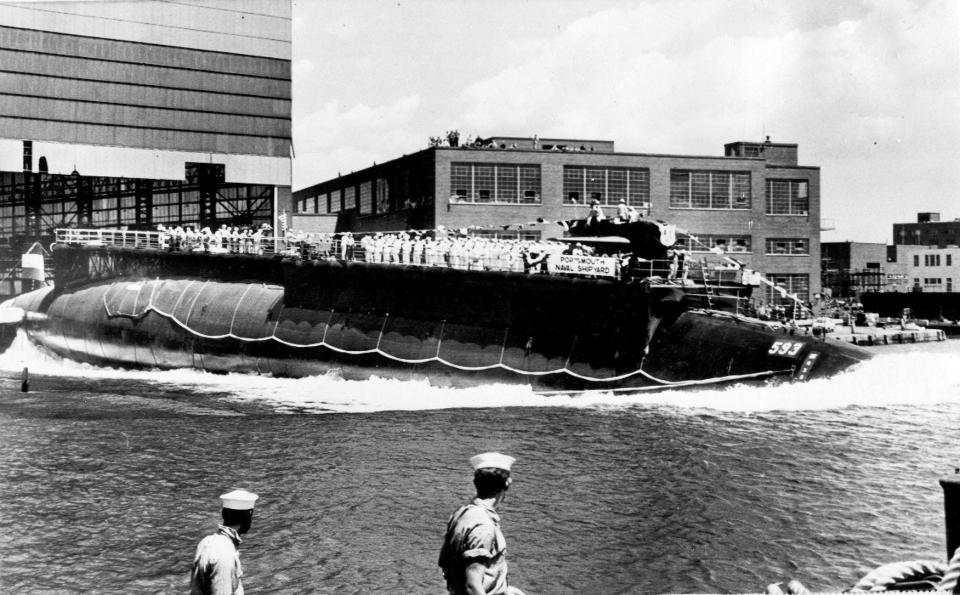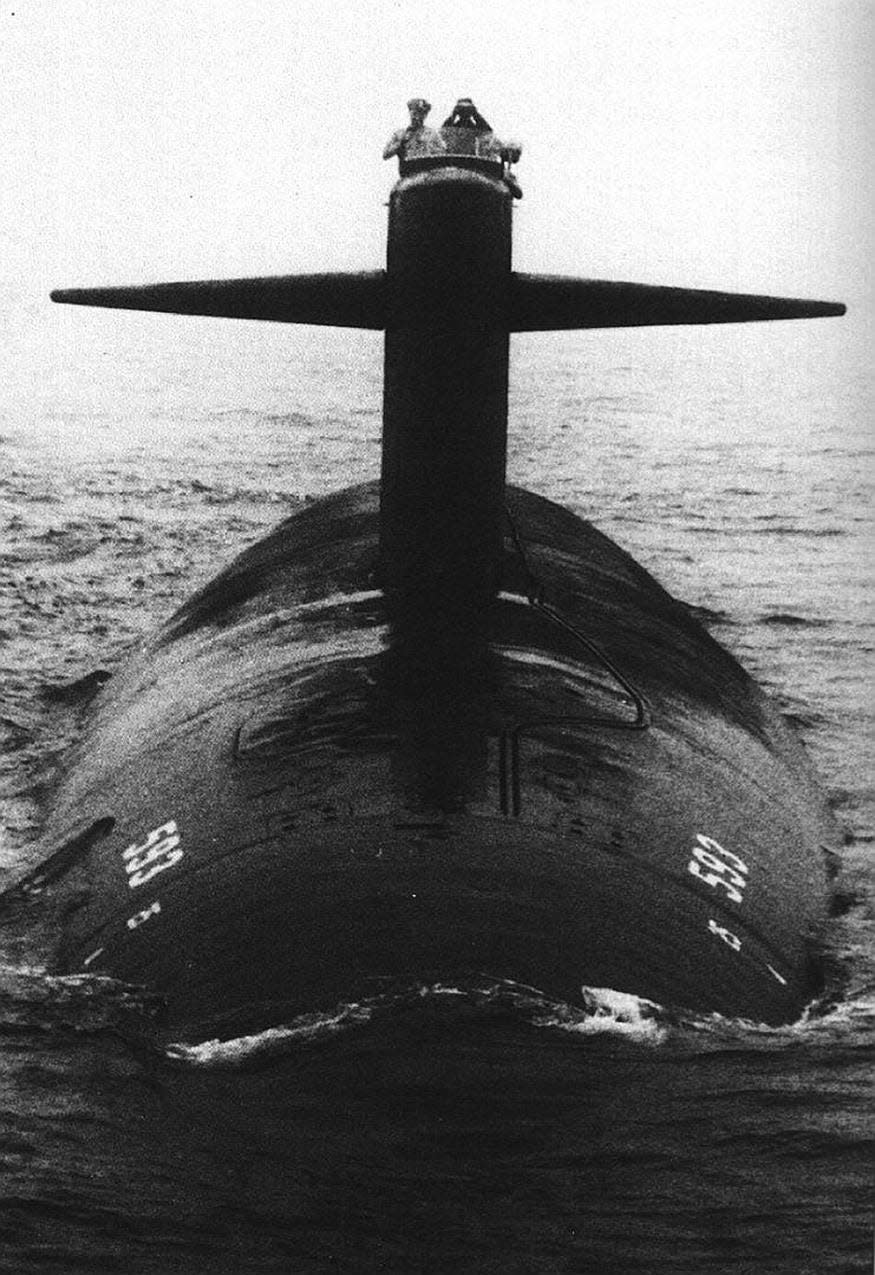Kerr: Reflecting on Kittery's iconic USS Thresher flagpole on 60th anniversary of tragedy

This Monday, April 10, 2023 marks the 60th anniversary of the Kittery-built Navy submarine USS Thresher’s horrific loss during the height of the Cold War.
In recent years, this publication has run dozens of articles related to the disaster and the 129 brave patriots who perished off the New England coast that April morning of 1963. But from a personal perspective, a local perspective, I’m stunned to realize it’s already been a decade since the dedication of the 129-foot flagpole now rising from the center of our town’s Memorial Circle to honor these men.

While the flagpole has become an iconic landmark of Kittery, some drama preceded the memorable day of its dedication. And yet, I don’t recall ever having a doubt it would happen. There just seemed to be a sense of destiny around the whole thing.
My own involvement was sparked by a newspaper column I wrote in 2011 about Kittery, not long after moving here. Believe it or not, the Foreside area was an absolute ghost town back then. What is now the location of the insanely popular Lil’s Café was an empty bank building, and a bunch of other storefronts were empty. It. Was. Dead.
So I wrote what could be considered a snarky piece lamenting the fact that Kittery, with such an ideal seaside location and rich history, was not doing more with its enviable assets. Not long afterward, I received a letter from Gary Beers – a town councilor at the time – which included a list of proposed projects to enhance and celebrate Maine’s oldest town, and a comment that residents are always welcome to pitch in.
In his gentlemanly and rather courtly way, Gary was basically inviting me to put up or shut up.
One of the projects that really struck me was the plan to install a 129-foot flagpole to mark the upcoming 50th anniversary of the world’s worst submarine disaster. As a local history buff and old Navy guy myself, I was amazed that I didn’t know more about the loss of the USS Thresher.
Photo archive: Thresher: 129 Lives Lost, Part 1
Photo archive: Thresher: 129 Lives Lost, Part 2
The disappearance and desperate Navy search for SSN 593 during the week before Easter Sunday of 1963 was a huge international news story at the time. It marked the first time a nuclear submarine had ever been lost at sea, and occurred just six months after the Cuban Missile Crisis. Almost 50 years later, it seemed only the Navy’s submarine community, surviving family members, and residents with long memories still recalled the Thresher.
And yet, as SSN 593 was designed, built and commissioned here at Portsmouth Naval Shipyard, and had just completed a major overhaul prior to her fateful sea trials that April, she was very much a hometown vessel.
So I pitched in. Gary – who seemed to have held just about every position available to the Kittery community at one time or another – and Gerry Mylroie, the veteran town planner, knew all the procedures and nuances required to get things done here. But if this effort was to be privately funded, I figured folks might be more compelled to contribute if they could associate names and faces with the men represented by the 129-foot flagpole.
During the year leading up to the 50th anniversary, I wrote a series of monthly articles for the Portsmouth Herald, focusing on the men who had gone down aboard the Thresher. Two – Fred Philip Abrams and Richard DesJardins − were Traip Academy graduates who each grew up within a stone’s throw of Portsmouth Naval Shipyard, where they were both employed when they boarded the doomed sub as civilian observers.
Two of the Thresher’s Navy crewmen – Donald Nault and Peter DiBella, the youngest casualty at just 19 years old – were born and raised in Portsmouth, New Hampshire, and excited to serve aboard the hometown submarine.
When we approached the Fabulous Find thrift store to apply for a donation, the woman at the counter – Debby Ronnquist – turned out to be the widow of crew member Julius Morello Jr. The organization was founded by his daughter Marcye Philbrick, just two years old when her dad was lost aboard the Thresher.

These stories and others made us realize the extent of how deeply the Thresher’s story was intertwined with the Seacoast community. Donors did as well, as area businesses, organizations and individuals stepped up in a big way, either through financial contributions or other services.
But there were still obstacles. Some in town were opposed to having a 129-foot flagpole in the middle of Kittery’s traffic circle, especially when rumor circulated that it would be the equivalent height of a 13-story building. I’m frankly not sure there’s a 13-story building in the entire town, but this notion freaked out critics.
Personally, I’ve always felt the pivotal moment of the whole campaign was when former President George H W Bush expressed his support. I had originally tried to contact former President Jimmy Carter, himself a Navy submariner back in the 1940s and ‘50s, but don’t know if my correspondence ever got through.
Then I remembered we had another former POTUS – and genuine World War II Navy hero – right up the coast in Kennebunkport. I still remember getting an excited call from Gary after he saw Bush’s return address on incoming mail. I was out for a walk with my little girl, so we met at a sidewalk along Rogers Road and opened the envelope together like a couple of giddy schoolboys receiving a reply to a Ted Williams fan letter.
The president and former Navy pilot provided not only a very gracious note of support but also a personal check for $500 toward the effort. In my mind, this donation really legitimized the effort.
Another key moment was getting Maine’s U.S. Sen. Susan Collins as our keynote speaker for the April 7, 2013 ceremony. Originally, she wasn’t able to work it into her schedule so I tried to get her predecessor Bill Cohen – also a former secretary of defense – but Cohen was otherwise booked as well. Then Collins was able to accept our invitation after all.
One thing I’ll never forget about that day was how Collins was introduced to Debby, who shared her story of being widowed with two babies at 22 years old when her sailor husband Julius was lost aboard the Thresher. During her remarks from the podium shortly afterward, the senator masterfully wove Debby’s story into her prepared remarks, helping to personalize this epic tragedy.

Vice Adm. Michael J. Connor, the commander of America’s submarine forces at the time, also spoke to the crowd that day. I found it quite karmic that Connor was a native New Englander and 1980 graduate of Maine’s own Bowdoin College.
Finally, I’ve always believed David Kelly was the unsung hero of this effort. If memory serves, the former Shipyard assistant fire chief provided the original idea for a 129-foot flagpole to honor the Thresher but I don’t believe I ever met the man. Gary masterfully oversaw the administrative aspects, Gerry provided vision and guidance, but the landmark we enjoy today was initiated by Kelly’s foresight.
D. Allan Kerr is a former member of the Thresher Memorial Project Group.
This article originally appeared on Portsmouth Herald: Kerr: USS Thresher tragedy 60th anniversary; Kittery flagpole stands tall

 money
money 